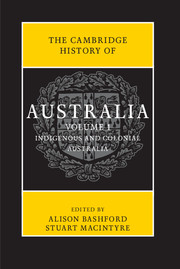Book contents
- Frontmatter
- Contents
- Abbreviations
- List of maps
- List of figures
- List of tables
- Notes on contributors
- Map
- Preface
- Introduction
- PART I
- PART II
- Further reading
- Chronology
- Index
- Frontmatter
- Contents
- Abbreviations
- List of maps
- List of figures
- List of tables
- Notes on contributors
- Map
- Preface
- Introduction
- PART I
- 1 Nation building, 1901–14
- 2 The Great War and its aftermath, 1914–22
- 3 Search for a solution, 1923–39
- 4 World War 2 and post-war reconstruction, 1939–49
- 5 The Menzies era, 1950–66
- 6 Instability, 1966–82
- 7 Growth resumed, 1983–2000
- 8 The new millennium
- PART II
- Further reading
- Chronology
- Index
1 - Nation building, 1901–14
from PART I
Published online by Cambridge University Press: 05 November 2013
- Frontmatter
- Contents
- Abbreviations
- List of maps
- List of figures
- List of tables
- Notes on contributors
- Map
- Preface
- Introduction
- PART I
- PART II
- Further reading
- Chronology
- Index
- Frontmatter
- Contents
- Abbreviations
- List of maps
- List of figures
- List of tables
- Notes on contributors
- Map
- Preface
- Introduction
- PART I
- 1 Nation building, 1901–14
- 2 The Great War and its aftermath, 1914–22
- 3 Search for a solution, 1923–39
- 4 World War 2 and post-war reconstruction, 1939–49
- 5 The Menzies era, 1950–66
- 6 Instability, 1966–82
- 7 Growth resumed, 1983–2000
- 8 The new millennium
- PART II
- Further reading
- Chronology
- Index
Summary
Since there was no urgency over the formation of the Australian Federation, the timing of its inauguration could be planned well beforehand. The premiers of the six colonies agreed on the date of 1 January 1901. The opening of a new century seemed fitting for the launching of a new nation that appeared destined, given all its advantages, to be in the van of progress. Australia possessed a whole continent with no frontiers other than the sea, and its people were of one stock (British) with no entrenched enmities or social division, who enjoyed the highest living standards in the world. The Indigenous population, devastated by the European invasion, was assumed to be dying out.
The actual circumstances of the new nation were dire. The effects of the bank collapses and Depression of the early 1890s had not disappeared when they were followed by a severe drought that ran from 1895 to 1903. It is now known as the Federation Drought. Though Australia was a highly urbanised society, it was heavily reliant on its rural industry. Small-scale wheat farming was becoming more widespread, but the nation's staple was still wool growing, which the drought devastated. Sheep numbers fell from 100 million to 50 million. Only Western Australia escaped depression, a result of the discovery of gold at Coolgardie and Kalgoorlie. Melbourne, which had become the largest city in the country as the result of the gold rushes of the 1850s, was hit hardest by the Depression. Tens of thousands of its people migrated to the west. Sydney, the founding city of the nation, overtook Melbourne in population in the 1890s and kept its pre-eminence.
Australia was losing population through emigration when the Commonwealth was created. Migration from the United Kingdom had virtually ceased and did not resume until 1906, when the States recommenced the subsidy schemes that were necessary to attract migrants to such a remote destination. Though not envisaged by the constitution makers, the federal government involved itself in the organising and promotion of migration.
- Type
- Chapter
- Information
- The Cambridge History of Australia , pp. 15 - 38Publisher: Cambridge University PressPrint publication year: 2013
- 1
- Cited by



